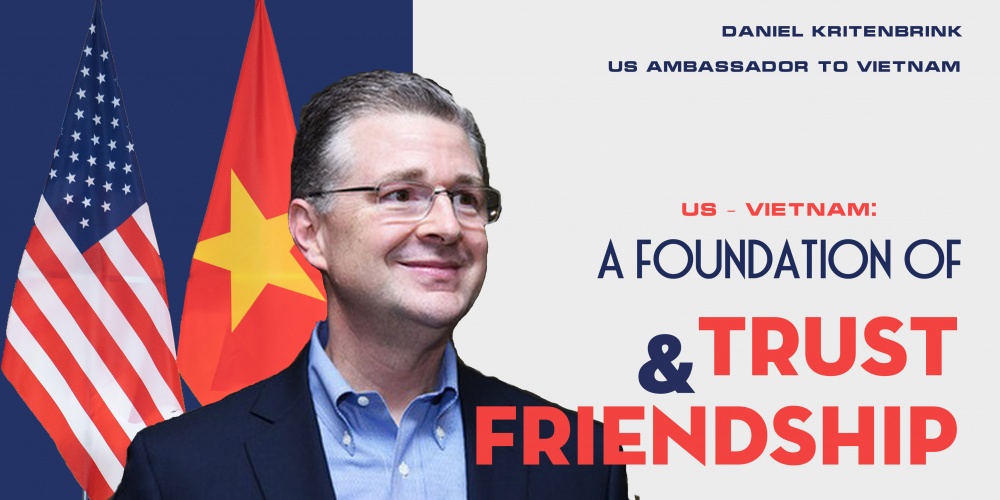 |
US Ambassador to Vietnam Daniel Kritenbrink believed that the fruitful bilateral cooperation after 25 years of the establishment of diplomatic relations would serve as a strong foundation for future development in the US – Vietnam relationship.
***
In 1995, when President Bill Clinton announced the normalization of US diplomatic relations with Vietnam, our two countries had nearly no trade and very limited people-to-people connections. Today, in areas as diverse as trade, development, education, health care, energy, and security, the United States and a strong, prosperous, and independent Vietnam are working together with a shared commitment to peace and prosperity. We truly are trusted partners, with a friendship grounded in mutual respect. Looking at all we have achieved together, the progress of the US - Vietnam bilateral relationship over the past 25 years has been nothing less than extraordinary.
 |
Our predecessors set aside their differences, acknowledged our history, and vowed to move forward as friends instead of foes. Veterans and families on both sides were among the first to face the past and start building the bridges that allowed our governments to successfully engage. Americans and Vietnamese began working together to address humanitarian issues and the legacies of war years before the normalization of relations. Since 1988, American and Vietnamese teams have partnered to recover our fallen soldiers, and in 1991, the US Office for Prisoners of War/Missing in Action Affairs opened in Ha Noi. Under President George H.W. Bush, the US Agency for International Development (USAID) began providing assistance to persons with disabilities in Vietnam using the Leahy War Victims Fund. Starting in 1993, the US and Vietnam began working together to help rid Vietnam of the scourge of unexploded ordnance (UXO).
We also took early steps to build people-to-people ties, opening the Fulbright program in 1992, followed by the establishment of the Fulbright Economics Teaching Program (FETP) in 1994. These programs trained thousands of policymakers, educators, and business leaders. Two examples, among many: Prime Minister Nguyen Xuan Phuc is an FETP alumnus, and Deputy Prime Minister and Foreign Minister Pham Binh Minh received a Fulbright scholarship to study in the US.
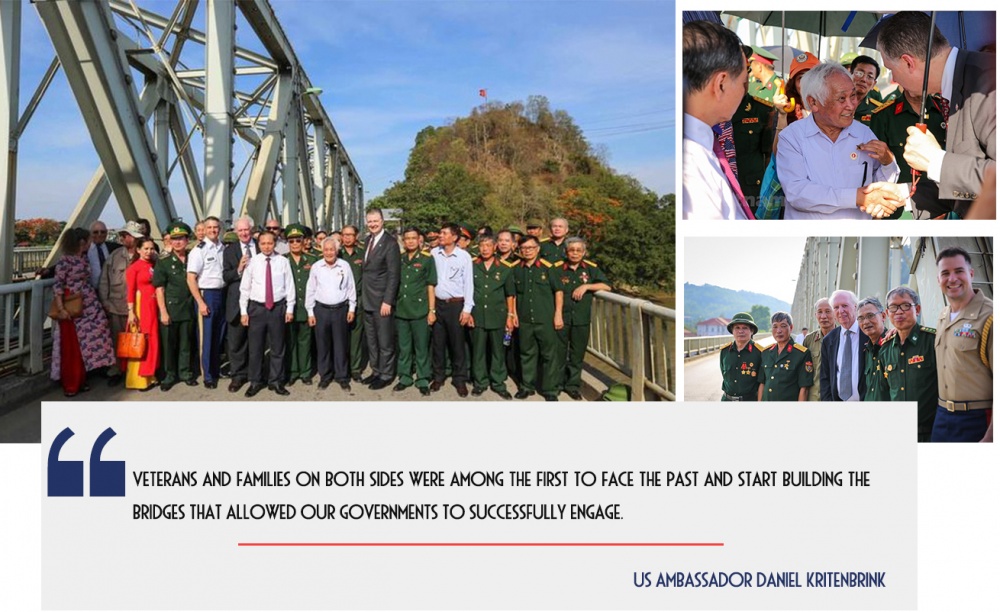 |
These first steps our two nations took together set the stage for the formal establishment of diplomatic relations and the opening of our two embassies in Washington and Ha Noi in 1995. Then, in 1997, the US Senate confirmed Douglas “Pete” Peterson as the first US Ambassador to the Socialist Republic of Vietnam. Ambassador Peterson, who served as a US Air Force pilot during the war in Vietnam and spent over six years as a prisoner of war, devoted his tenure to reconciliation and building a lasting relationship between Vietnam and the US. He said, “I want to heal the wounds between the US and Vietnam. It’s a tragic history that we’ve shared as two peoples. No one can change that, but there is a great deal we can all do about the future. And that’s why I’m in Vietnam.” Ambassador Peterson was not alone in believing he could do a “great deal about the future” of US - Vietnam relations. Important figures in our two governments, including the late Senator John McCain, Senator Patrick Leahy, former Secretary of State John Kerry, late Vietnamese Foreign Minister Nguyen Co Thach, and Former Vietnamese Foreign Minister Nguyen Manh Cam and Ambassador Le Van Bang, many others, promoting a shared future of trust, peace, and prosperity.
As Secretary of State Mike Pompeo said, “In the past, we were opponents on the battlefield. But today, our security relationship is all about cooperation.” That cooperation happens at every level, from high-level visits by the Secretary of Defense to the men and women serving in our militaries. As an example, over the last three years, the US Coast Guard delivered 24 patrol boats and a 3,000-ton, 115-meter cutter to the Vietnamese Coast Guard, with US Coast Guard personnel joining the Vietnamese crew for the sail home. During his November 2019 visit to Ha Noi, Defense Secretary Mark Esper agreed to expand this program by transferring a second Coast Guard cutter in 2020. Vietnamese officers continue to attend US military Professional Military Education for Staff & War Colleges, and recently two Vietnamese pilots trained alongside American officers in the US Air Force Aviation Leadership Program. Members of the US military continue to work alongside Vietnamese counterparts to deliver humanitarian assistance and host cultural exchanges annually through Pacific Partnership. And we are excited to announce that this summer Vietnam will send its first-ever cadet to attend the US Air Force Academy. Our cooperation continues to grow in other important areas, including peacekeeping, demining, humanitarian assistance and disaster response, law enforcement, and criminal justice system reform.
 |
Every day, American and Vietnamese business leaders develop strong trade ties enabling our commercial partnership to prosper. We have gone from almost no trade 26 years ago to over $77 billion in two-way trade today. Major US firms have invested billions both in Vietnam’s manufacturing sector and in its infrastructure, and we expect US investment in energy and other infrastructure to continue and even accelerate under our Indo-Pacific Economic Vision. Together, entrepreneurs from our two countries continue to innovate and thrive. I believe our collaborative work to ensure the free and fair flow of goods and investment between our two countries will continue to contribute to our mutual prosperity. We are committed not just to economic growth, but to sustainable development. To accomplish this, we partner with Vietnam to protect and preserve its natural resources – working together, we are investing in sustainable forestry management; combating illegal, unreported, and unregulated fishing and illegal wildlife trafficking; and improving air and water quality.
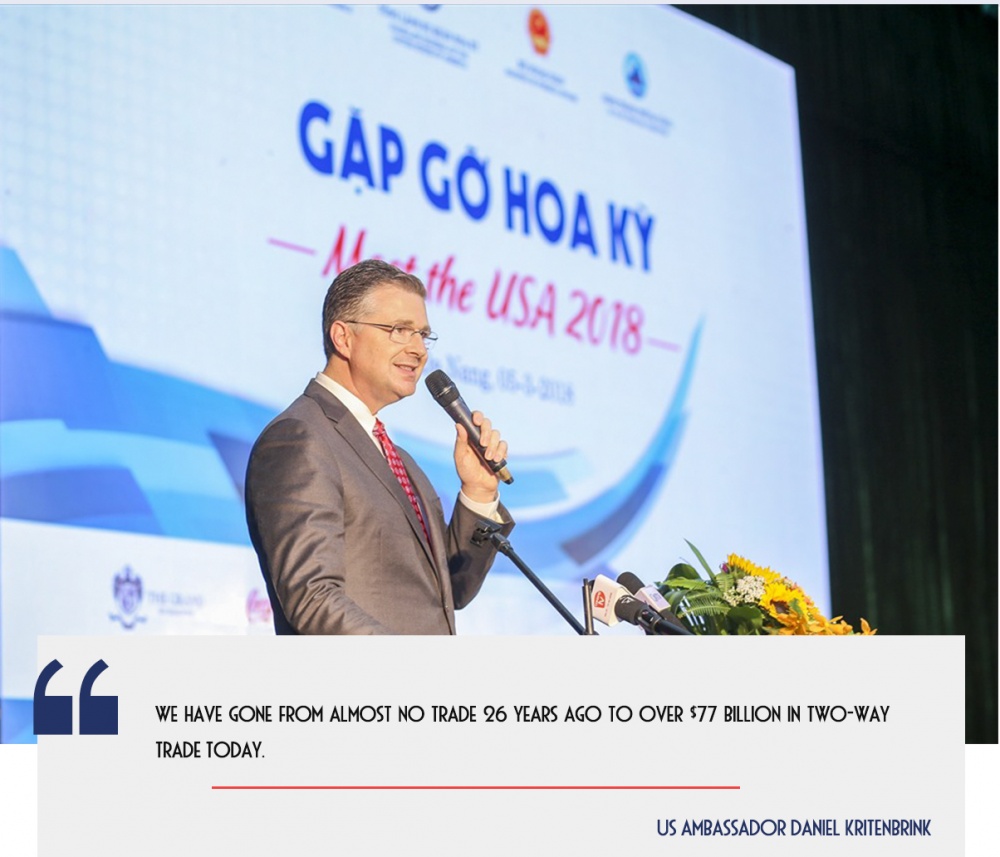 |
Investing in our future partnership means providing opportunities for our youth to start building lasting ties of friendship. The Vietnam Education Foundation, established in 2000, provided nearly 600 fellowships for Vietnamese students to receive master’s degrees and PhDs in science, technology, engineering, and mathematics. VEF alumni are now serving as professors in universities across Vietnam, training the next generation of Vietnamese scientists and engineers. Every year, tens of thousands of young Vietnamese citizens study at universities in the US. They contribute to academic excellence on our campuses, and they return to Vietnam with world-class educations, ready to contribute to the growing economy. In addition to helping Vietnamese students pursue their education in the US, we are also assisting Vietnam’s efforts to modernize its higher education system. We are proud to support Fulbright University Vietnam (FUV), the first private, independent, non-profit Vietnamese university, which combines Vietnam’s rich cultural traditions and heritage with American higher education traditions of open inquiry, research, and critical analysis. FUV is bringing world-class university standards to Vietnam and helping to unlock the tremendous potential of Vietnam’s education sector.
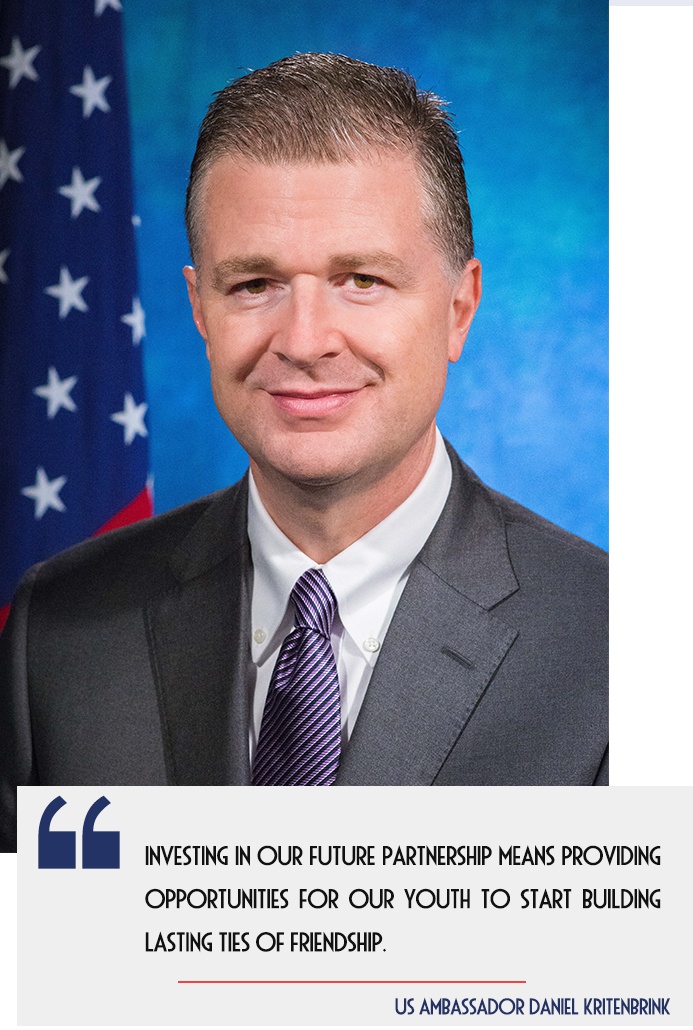 |
Although our partnership with Vietnam remains focused squarely on the future, we continue to work actively on humanitarian and legacy-of-war issues. We do so out of a recognition that these issues were not only the “bridge” that brought our two countries back together in 1995, but today remain a fundamental element of our relationship going forward. Since 1988, 727 missing US personnel from the war have been accounted for thanks to the work of American and Vietnamese teams partnering to recover our fallen soldiers. And now, we are actively working to assist Vietnam in an account for its own missing in action from the war. During my time as US Ambassador to Vietnam, I have had the great honor of visiting both Truong Son Cemetery and Bien Hoa Cemetery to pay my respects to all Vietnamese soldiers killed during the war. These were extremely moving experiences for me personally, carried out in a spirit of reconciliation and mutual respect.
Since 1989, the US has provided over $113 million to assist persons with disabilities in Vietnam, helping millions of Vietnamese in need. Since 1993, the US has contributed over $130 million to help Vietnam remove unexploded ordnance (UXO). Our partnership with the government of Vietnam on this front has been so successful that in the past two years there have been no UXO-related injuries in the US government-supported province of Quang Tri. In 2018, USAID successfully completed a $110 million dioxin remediation project at Da Nang Airport, and last year we began, together with our Vietnamese partners, massive dioxin remediation at Bien Hoa Airbase, the final major dioxin hotspot in Vietnam.
 |
The US - Vietnam partnership is also responding to the urgent challenges of today. This year, the US and Vietnam have built upon our long-standing cooperation in the health sector to strengthen Vietnam’s capacity to respond to the COVID-19 pandemic. The US Mission to Vietnam is fortunate to have three different agencies, each with complementary assets and expertise, contributing to the fight. The US Agency for International Development (USAID) has leveraged its long history in Vietnam - going back to 1989 - to rapidly mobilize non-governmental partners and resources to support the urgent response to the pandemic. The US Centers for Disease Control and Prevention (CDC), building on its 22-year relationship with the Ministry of Health, has provided direct technical assistance to governmental partners in the context of a rapidly changing scientific landscape. The Embassy’s Health Affairs Attaché, an office of the US Department of Defense, has worked closely with other sections in the Mission to explore opportunities for exchange of information and materials related to personal protective equipment, ventilators, and other technologies. These three agencies, working together to support Vietnam, are bringing Vietnam and the US even closer together.
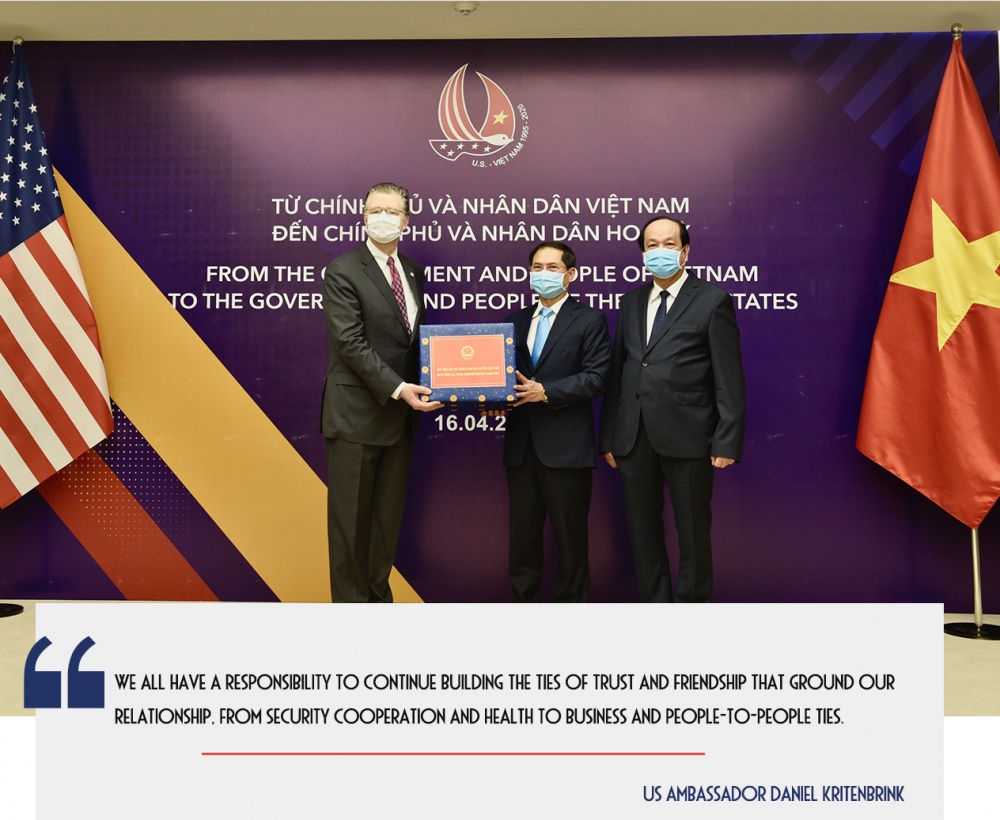 |
Looking back at how much the US and Vietnam have achieved together over the past 25 years, and even before 1995, it is clear that our two nations have much to celebrate this year. Yet, I think it is important to recognize that our work is not over. There are, naturally, areas where we would like Vietnam to do more, and where our two sides have differences. As friends, we address these issues openly and frankly with Vietnam’s leaders, listen carefully to their responses, and work together on common solutions.
When I hear people say that all we have achieved in the US - Vietnam relationship is a miracle, I reflect on what Ambassador Peterson once told me: our shared progress is indeed remarkable, but it was not an accident. Everything we have achieved has been built on the courage, goodwill, and painstaking work of those who came before. The strong Comprehensive Partnership that we share today is the result of countless actions and decades of sincere dedication by individuals from both of our great countries. We all have a responsibility to continue building the ties of trust and friendship that ground our relationship, from security cooperation and health to business and people-to-people ties. I look forward to continuing to advance our bilateral relationship in 2020, and over the next 25 years of our partnership.
Editor: Quan Luu
Photos in courtesy of United States Embassy in Vietnam, The World & Vietnam Report, Vietnam News Agency, Lao Dong
Designer: Minh Nhat
